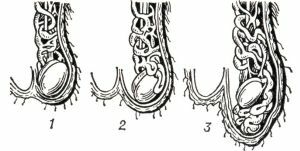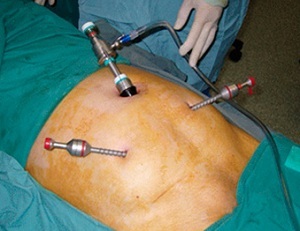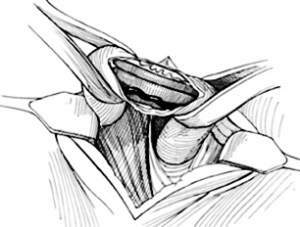 Currently, a fairly common phlebological disease in men is varicocele. The disease is an expansion and an increase in the veins in the area of the spermatic cord and testicle.
Currently, a fairly common phlebological disease in men is varicocele. The disease is an expansion and an increase in the veins in the area of the spermatic cord and testicle.
There are four degrees of varicocele, the symptoms and treatment on each of them are different.
Contents of
- Stages of development of the disease
- Signs of the disease
- Diagnosis
- Complex of therapeutic measures
- Probable complications
- Complications for the 1 st to 2 stages of the disease
- Consequences of the 3rd to 4th stages of the disease
The stages of the development of the disease
On its way the varicocele undergoes 4 stages of development:
- Diseaseon 1 degree of development is often called zero or latent stage. Visually determine the disease of this
 degree is impossible, as well as by probing in the absence of visible changes. The progression of the disease at this stage often occurs asymptomatically, in rare cases, there may be a creeping sensation in the testicle and spermatic cord. Due to such a lingering course of the disease, many patients learn about it at a later stage.
degree is impossible, as well as by probing in the absence of visible changes. The progression of the disease at this stage often occurs asymptomatically, in rare cases, there may be a creeping sensation in the testicle and spermatic cord. Due to such a lingering course of the disease, many patients learn about it at a later stage.
- The second stage of the disease is also almost imperceptible and manifests itself only when the patient is in a standing position or after physical exertion.
- Varicocele 3rd degree already proceeds with pronounced symptoms and begins to bring discomfort.
- On the of the fourth stage of the , the symptoms of the disease are pronounced, and can lead to infertility.
Symptoms of the disease
Such a disease, as varicocele, in the early stages of its development often occur completely without symptoms. Progression of pathology begins already in the pubertal period.
In this case, at grade 1 and 2 varicocele, if there are any primary symptoms, they often do not include pain. In rare cases, changes in the size of the scrotum and testicle can be observed at stages 1 and 2, which can be seen clearly in the later stages.
 Already from the second stage of the disease, unpleasant sensations in the testicles and groin as a whole, due to physical exertion, may appear. In advanced stages, such symptoms can occur at any time.
Already from the second stage of the disease, unpleasant sensations in the testicles and groin as a whole, due to physical exertion, may appear. In advanced stages, such symptoms can occur at any time.
In the late stages of the disease( stages 3 and 4), the symptoms manifest themselves with minor physical exertion, such as walking. Particularly felt discomfort at the time of sexual intercourse. In the 3rd and 4th stages of the varicocele, the scrotal enlargement on the left side is observed with the patient standing up, in the recumbent state everything returns to natural dimensions.
Stage 3 is characterized by the appearance of persistent pain, a significant increase in the size of the testicles and scrotum, but in 4 stages there is a significant decrease and softening of the tissues. The contour of the veins during this period is rather distinct.
Diagnosis of
In the first stage, palpation of the testicles is useless, so for the diagnosis of the disease resort to instrumental examination. Due to the fact that no complaints from patients are received, and the symptomatology is in most cases absent, the physical examination methods are also not applied. The fact of the disease is often established during a screening examination.
Instrumental methods for the diagnosis of varicocele 1 degree include dopplerography of vessels and ultrasound of the scrotum. In addition, specialists resort to the spermogram. In this case, everything is taken into account, the volume of sperm excretion, its consistence, the number of spermatozoa and the ratio of mobile and non-mobile, and so on.
In order to diagnose the disease of the second stage, the specialist conducts palpation. Thus the patient is in a standing position. In addition, the ultrasound of the scrotum, spermogram and tests are performed.
In the third stage, palpation is used to determine the pathology, and the patient's  position does not matter at all because of the pronounced symptomatology. Also, all kinds of diagnostics are used, which are carried out at stages 1 and 2.Conducting laboratory studies, it is possible to establish the number of spermatozoa, mobile and not.
position does not matter at all because of the pronounced symptomatology. Also, all kinds of diagnostics are used, which are carried out at stages 1 and 2.Conducting laboratory studies, it is possible to establish the number of spermatozoa, mobile and not.
At the last stage, the pathology has a pronounced symptomatology, so varicocele is easy to identify at a glance.
In addition, it is necessary to inspect the doctor and apply all diagnostic methods that are used at stages 1,2 and 3, to clarify the degree of complexity of the pathology and the correct selection of the method of treatment.
Complex of therapeutic measures
Even with varicocele of 1 degree, specialists most often resort to surgery. This method is used for patients who want to have children without problems.
Various methods of operation are used:
- open , implying vein ligation over the inner ring of the inguinal canal;
- is carried out revascularization , specialists resort to microsurgery, which involves the transplantation of the testic vein into the epigastric;
- laparoscopic or endoscopic operation , which involves tying the testicular vein;
- X-ray endovascular is an operation in which special substances are introduced into the vein to block the vein;
- bypass , which is performed by inserting a shunt into the affected testicle, after the procedure is over, with the help of it, the outflow of excess blood will be carried out.
After the operation, both at the first and the second stage, for an early recovery, a specialist can prescribe the intake of vitamins.
There is also a conservative treatment in the first stage. However, if you follow all the prescriptions of specialists, occasionally surgical intervention can be avoided or postponed.
 Conservative methods of therapy involve the elimination of symptoms. Also, in the event that in addition to all the symptoms of constipation, they need to get rid of.
Conservative methods of therapy involve the elimination of symptoms. Also, in the event that in addition to all the symptoms of constipation, they need to get rid of.
In this case, experts recommend medication, diets and only as a last resort surgical intervention. In addition, there are some precautionary measures, for example, a ban on heavy physical activities and lifting weights.
There are a number of indications, including a call for active sexual life, as this helps improve blood circulation.
It is also required to wear a special bandage that supports the scrotum in a slightly elevated state. In addition, therapeutic gymnastics and drugs are prescribed, which are aimed at strengthening the walls of blood vessels and increasing microcirculation of blood flow.
As for the second stage of the disease, conservative treatment is also used here, but more often the use of operational methods is prescribed. This depends primarily on the severity of the pathology. And conservative treatment helps only a small percentage of patients.
Treatment varikotsele 2 degrees is aimed primarily at eliminating the focus of the disease, so the following methods are used:
- operation Marmara , as the main treatment method, involving vein ligation;

- the expert conducts massage of testicles to the patient who is in a horizontal position;
- are physical exercises , which consist of lowering and lifting on socks, and inclinations( you need to do this several times a day);
- the use of antioxidants and amino acids , which help to normalize the mobility of spermatozoa and improve their quality.
In the treatment of grade 3 and 4 varicocele, specialists direct forces to stop the return flow of blood to the diseased organ from the body.
The most effective treatment for this stage is embolization and surgical ligation. But if the patient plans to have children in the future, the specialists resort to the second method.
In this case, drug treatment, traditional medicine and other methods are simply useless. After the operation, the size of the genitals returns to normal, and a bunch of veins disappears.
Probable complications of
There may be quite definite complications at each stage of the disease. Thus, the conditional effects of the disease can be divided into 2 groups.
Complications for stages 1 - 2 of the disease
In general, complications after surgery in the initial stages of the pathology are unknown, since there have been no such cases. But in the event that the operation was conducted by an insufficiently good specialist and accordingly turned out to be of poor quality, then the probability that the disease will start to develop again after a while, relapses the disease.
In order for the operation to be 100% effective, the procedure is determined by the degree of its effectiveness through palpation of the testicle and the delivery of tests.
Of course, surgery for varicocele in the initial stages, like any other surgical intervention, has a number of contraindications during the postoperative period and certain duties that are mandatory for the man to perform. Violation of them can lead to relapse.
Consequences of 3 to 4 stages of
 disease If treatment has not been started in a timely manner, this may be fraught with the possibility of having children for a man. Despite the fact that infertile couples often participate in research often refuse, volunteers also appeared who wanted to understand the source of their problem.
disease If treatment has not been started in a timely manner, this may be fraught with the possibility of having children for a man. Despite the fact that infertile couples often participate in research often refuse, volunteers also appeared who wanted to understand the source of their problem.
Studies have shown that the source of infertility is probably located in men with this disease. Of the participants in the focus group, 20-40% of men had a varicocele pathology, while in males with normal fertility, the pathology was observed in 10-15% no more.
In the case of a one-sided varicocele, how pathology can affect fertility is not yet clear. But studies have shown that the temperature of the scrotum in this case is colder, about several degrees, in contrast to the total body temperature.
This indicator is very important for the proper functioning of the testicle and for the normal production of sperm. This run-in temperature is observed due to the normal anatomy of the scrotum. In the case when the patient develops varicocele, the expansion of the veins affects the decrease in the efficiency of the mechanism, so instead of cooling in the area of the testicles, an increase in temperature may be observed.
Medicine does not stand still, so research continues to be carried out further. The results obtained from focus group participants showed that in patients with varicocele, the level of the main male hormone, i.e., testosterone, is significantly lower than normal.
But the negative impact on fertility is not all the consequences that can appear in patients with grade 3 and 4 varicocele. As a result, the disease can lead to testicular atrophy. This outcome is the result of a disturbance of the blood flow to the testicle and the spermatic cord. In turn, the disturbed blood flow leads to a lack of oxygen in the blood vessels.
